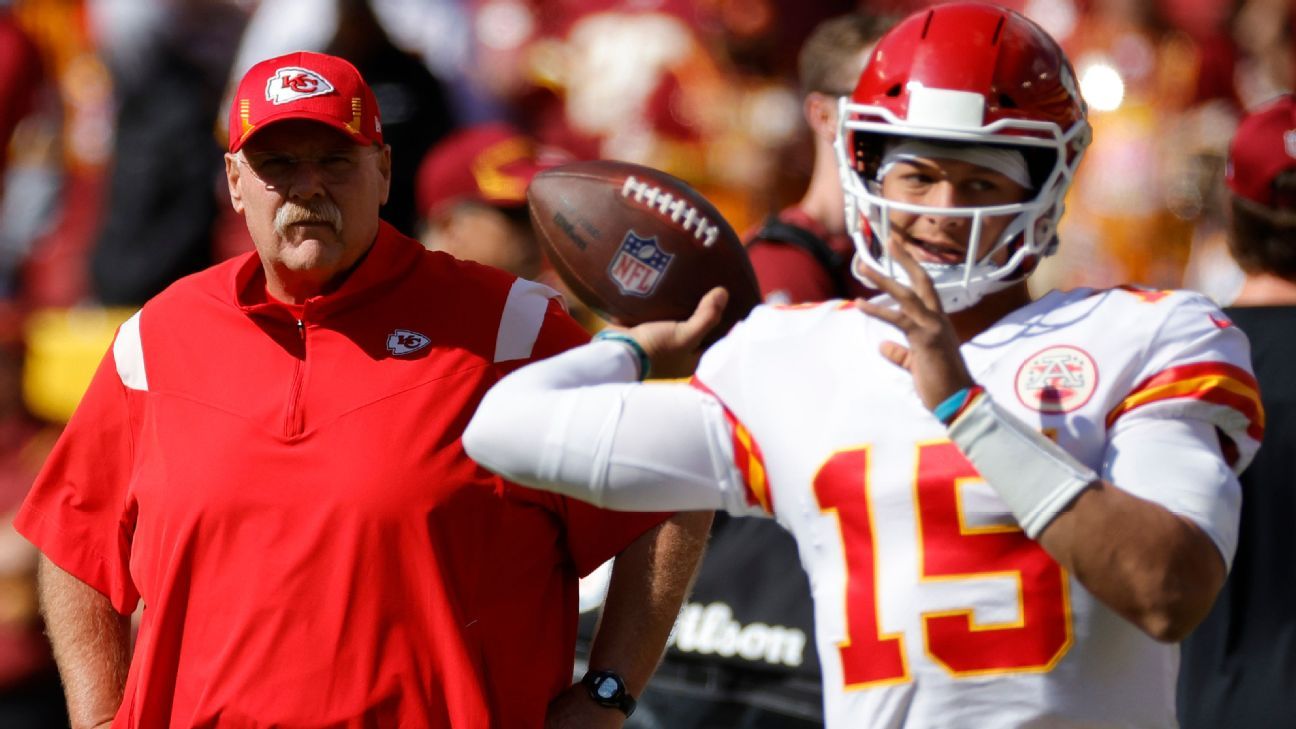In just two days, the Bills will use what could be their most substantial team-building resource before the 2022 season. The 25th selection in the NFL Draft can give them one last boost for their critical upcoming campaign.
Many consider this one of the most unpredictable first rounds in recent memory. So how does that affect the Bills, and what might they be targeting starting Thursday? We’ve got a lot to get to, so let’s dive right in with a draft week tradition.
Here are 22 thoughts about the Bills’ potential draft strategy, combining what the Bills have said, historical clues, positional values, recent trends, roster structuring and an absurd amount of time by yours truly considering every possible scenario.
1. Why the Bills make this unpredictable draft even trickier
Projections for the Bills’ pick at No. 25 are all over the board, and there’s a good explanation for it. For one, the Bills have a great roster, and one that many believe can contend for a Super Bowl. For many, that narrows the focus to an immediate need like cornerback because of Tre’Davious White’s injury and the Dane Jackson factors. However, as we wrote about at length last week, the Bills have long treated the second boundary cornerback position as a non-premium position. That historical viewpoint lessens the case for it to be the top pick, and we’ll get into it more later. But cornerback isn’t the only position with that distinction, and it’s why figuring out what they’ll do has been so difficult.
Since Bills general manager Brandon Beane has been in charge, the Bills have used their first-round selection on what the organization believes to be a premium position. A quarterback and a middle linebacker in 2018, a disruptive three-technique defensive tackle in 2019, trading the pick in 2020 for a top-flight receiver and then an edge rusher with plenty of potential in 2021. They used five first-round choices on five premium positions. However, here’s where it gets complicated. The Bills believe they are in a pretty good spot in almost all of those premium positions for 2022 and beyond.
The Bills’ most commonly projected positions have one of two aspects to them. First, some are non-premium, like a second cornerback, running back or guard. Or it’s overkill at a position loaded with talent, like receiver, linebacker or safety. Every other premium spot is taken care of with a multiyear deal. It’s a pretty great position to be in organizationally. But it also means we have to dig deeper, so let’s sift through some past quotes to try to figure out what Bills are thinking.
2. What lessons can we learn from previous draft years?
Much like this year, a second cornerback was viewed as a humongous Bills need externally in 2021. But they didn’t take one in the first round. This was a clue.
“We’ll think long term more than short term,” Beane said in April 2021. “I think there’s some other guys we have on the board, where we’re going: ‘This guy’s one heck of a player, but he’s not going to start Day 1, but we will count on him and maybe in a year he’s going to be the starter.’ We’ll have a player that’s on the last year of their deal, and he’ll kind of back up that player, learn from him, compete with him, but we don’t necessarily expect him to start.”
That exact scenario played out with the Bills’ last two first-round picks. In 2019, the Bills drafted defensive tackle Ed Oliver with then-presumed starter Jordan Phillips on a one-year contract. The team rotated Phillips and Oliver, sometimes playing them together, but each ended the year with only 53 percent of snaps. In 2021, the team drafted defensive end Greg Rousseau as incumbent starters Jerry Hughes and Mario Addison were both in the final year of their contract. Rousseau received only 49 percent of all defensive snaps in his rookie season, sandwiched between Hughes (51) and Addison (44).
The Bills typically don’t overplay their rookies or hand them a starting job immediately, a philosophy we outlined last week. Coach Sean McDermott actively manages first-year players’ time to limit the impact of the rookie wall. Five seasons into the Beane-McDermott era, it’s logical to believe they’d continue to operate the same way. The odds that the player they draft with their top pick becomes a Day 1 starter by choice in 2022 are not good from a historical perspective.
That first-year development is why Beane’s quote about having the long-term in mind matters as much as it does. And it’s why it’s essential to look at the positions where the Bills have only a one-year solution at the moment.
3. OK, so what positions fit those criteria for 2022?
There is a handful. We’ll go down the list in the order of standard position listings.
- Running back
- Slot receiver
- Tight end
- Guard
- Starter Rodger Saffold signed a contract that voids after the 2022 season.
- Linebacker
- Second cornerback
- Strong safety
- Jordan Poyer is in the final year of his contract, and it’s clear that he wants a raise and an extension.
The Bills are more likely to extend Knox than to draft his replacement, so we’ll rule that one out. You can make a sound argument for any remaining positions using the one-year ramp-up criteria. And on defense, one spot stands out.
4. Logic points to a DB at No. 25, but not the one you think
Ever since the Bills stormed through free agency, the chorus of “draft a cornerback at No. 25” has been a common refrain from the fan base. Mock drafts over the past month have followed suit. But in the grand scheme, the Bills would benefit far more in their defensive system from investing a premium pick into a safety than a cornerback. Follow their investments in the defensive backfield as a paper trail. They have given two substantial contracts to their starting safeties while banking on late-round prospect development and one-year prove-it deals at second cornerback. The strategy has worked. They can hide a second boundary cornerback to a certain degree. You can’t hide someone who lacks the versatility to play both the deep middle and inside the box for dependable run defense. If they whiff on a play, there are significant ramifications.
Their safeties have been a big reason the Bills have been so consistent and successful over the past five years. Poyer and Micah Hyde have set the tone and continuously bailed out the defense with high-level play, being in the right places and forcing turnovers throughout their Bills careers. All good things must come to an end, and eventually, there will be a decline in play due to age. Poyer and Hyde are entering their age-31 seasons, and contract expirations are coming.
This is dependent on one factor: Poyer. If the Bills don’t extend him past this season, they will have a huge hole at safety beginning in 2023. Last week, the Bills kept everything in the past and present tense, giving no hint that they intend to get a long-term deal done with Poyer. That brings us back to what Beane said in 2021, and looking long term with a first-round pick to help a position that may have a vacancy past the current season. Of all the positions listed above, safety means the most to their success and is a premium spot with their philosophy. And don’t forget that Hyde is a free agent after the 2023 season. In 2024, Hyde would be entering his age-33 season. There is a distinct possibility that the Bills will have two new starting safeties in 2024. This year’s draft is the time to act to keep a vitally important position strong.
5. So why does a cornerback make less sense than safety?
I get it. Everyone is nervous about White’s return from a torn ACL last year because it’s an unknown in what could be a Super Bowl push. But it would be slightly shortsighted to invest in what the Bills have viewed as a non-premium position for what could be only a handful of games in 2022. Especially when signing a veteran is still a clear possibility. They also remain bullish on Jackson, a third-year player, just as they did with Levi Wallace early in his career, amid similar external questions. And then, when you factor in McDermott’s hesitance to play rookies, it makes it a bit of a tougher sell. There are other factors at play here, too.
For one, the cornerback class outside of the top two has not drawn a lot of praise. The sweet spot for cornerbacks seems to be on Day 2 and early into Day 3. Take the word of Senior Bowl executive director and 18-year NFL scout Jim Nagy.

The term “fool’s gold” isn’t exactly a ringing endorsement. It would not be a shock to see players commonly linked to the Bills, such as Clemson’s Andrew Booth Jr., Washington’s Kyler Gordon and Florida’s Kaiir Elam, be available in the second round.
If that’s not enough, it’s wise to look at Beane and McDermott’s history of working together. The duo has spent 10 drafts together — six with the Panthers and four with the Bills. In those 10 drafts, they have invested in a boundary cornerback pick in the first five rounds only three times. They have never selected a boundary cornerback in the first round. Only McDermott did that with White in 2017 in Buffalo while working as the de facto GM before the Bills hired Beane after that draft. And the corners Beane and McDermott have picked in the first five rounds — Josh Norman (fifth round, 2012), James Bradberry (second round, 2016) and Daryl Worley (third round, 2016) — have all been hits. The developmental aspect matters to drive down draft-day cost, and even in Buffalo with White, Wallace and Jackson, McDermott has shown he can get the most out of cornerback prospects.
Regardless, it does seem this is a year to invest in a boundary cornerback, but they’d be better off doing that on Day 2 or early on Day 3. We’ll come back to the cornerbacks later. As for the safeties, one stands out in a big way.
6. Why Kyle Hamilton is everything Beane usually covets
If Beane, McDermott and defensive coordinator Leslie Frazier could build a safety prospect from scratch, Kyle Hamilton would be the result. Hamilton (6-foot-4, 220 pounds) is at least two inches taller than every other prospect and 20 to 30 pounds bigger than the other top safeties. If there’s one thing that Beane loves to add with a first-round pick, it’s a player with elite size and traits who is unlike anyone else at his position. And there is no one else like Hamilton.
Hamilton’s versatility has both 2022 and long-term appeal, even with Poyer and Hyde as the top two safeties. He can give them reps as a base-defense linebacker and as a subpackage big nickel to cover tight ends or bigger slot receivers this year. He can also free up the Bills to use Poyer and Hyde in different ways, giving the Bills that much more of a dynamic feel to their scheme. Long term, he can fill almost any role they want while projecting best to Poyer’s strong safety spot. He can play the deep middle as a free safety, down in the box for run support and underneath coverage, and nickel corner in addition to his two possible roles in 2022. Hamilton has the fluidity to turn and run with receivers, and on top of it all, he has a playmaking instinct with a knack for big turnovers.
The Bills value versatility, instincts, recognition skills, range and playmaking heavily at safety. Hamilton has all of those, in addition to elite size and length. The cherry on top is that he just turned 21, which matches the Bills’ historical preference with their top pick (more on that in a bit). They’ll immediately find a way to take advantage of such a rare player, just as McDermott did with Shaq Thompson in Carolina when they didn’t have a starting role for him as a rookie.
It would be unwise to rule out any scenario with the Bills and a player like Hamilton. We have seen them get quite aggressive in moving up the draft board, usually for players with elite size and traits for their position, and Hamilton has both. Beane aims to hit a home run with his first-round pick every year, and when he finds a player he’s excited about, he will do what it takes to make it happen. If the Bills believe the player has the potential to become an All-Pro-caliber asset and has fallen below the level they value him in the draft, all bets are off. Because Hamilton plays a position that is less valued across the league, the Bills might be able to get the player some describe as “rare” and a “unicorn” at a massive discount. So then, let’s talk options for the Bills to go get Hamilton.
7. What is possible for the Bills to move up for Hamilton?
Beane didn’t do it in the last two drafts, but when he sees a player high up on his board falling, he’ll pounce. He traded up four times in his first two drafts with the Bills for quarterback Josh Allen, Edmunds, guard Cody Ford and Knox. He also admitted he tried to trade up for running back Zack Moss in 2020 but couldn’t find the right deal. As Hamilton represents a lot of what the Bills and Beane value out of a prospect, it’s time to analyze the cost of doing business.
Hamilton’s draft stock is all over the place. Some have him in the bottom half of the first round, while others have him potentially available in the teens. Tony Pauline of Pro Football Network reported that many in the league “think Hamilton ends up somewhere between picks 15 and 20.” We started it with the Giants at 7 and ended the pick before the Bills to account for all the possible Hamilton outcomes. Using the Rich Hill trade value chart as adapted by DraftTek.com, here are potential costs to move up in most years.
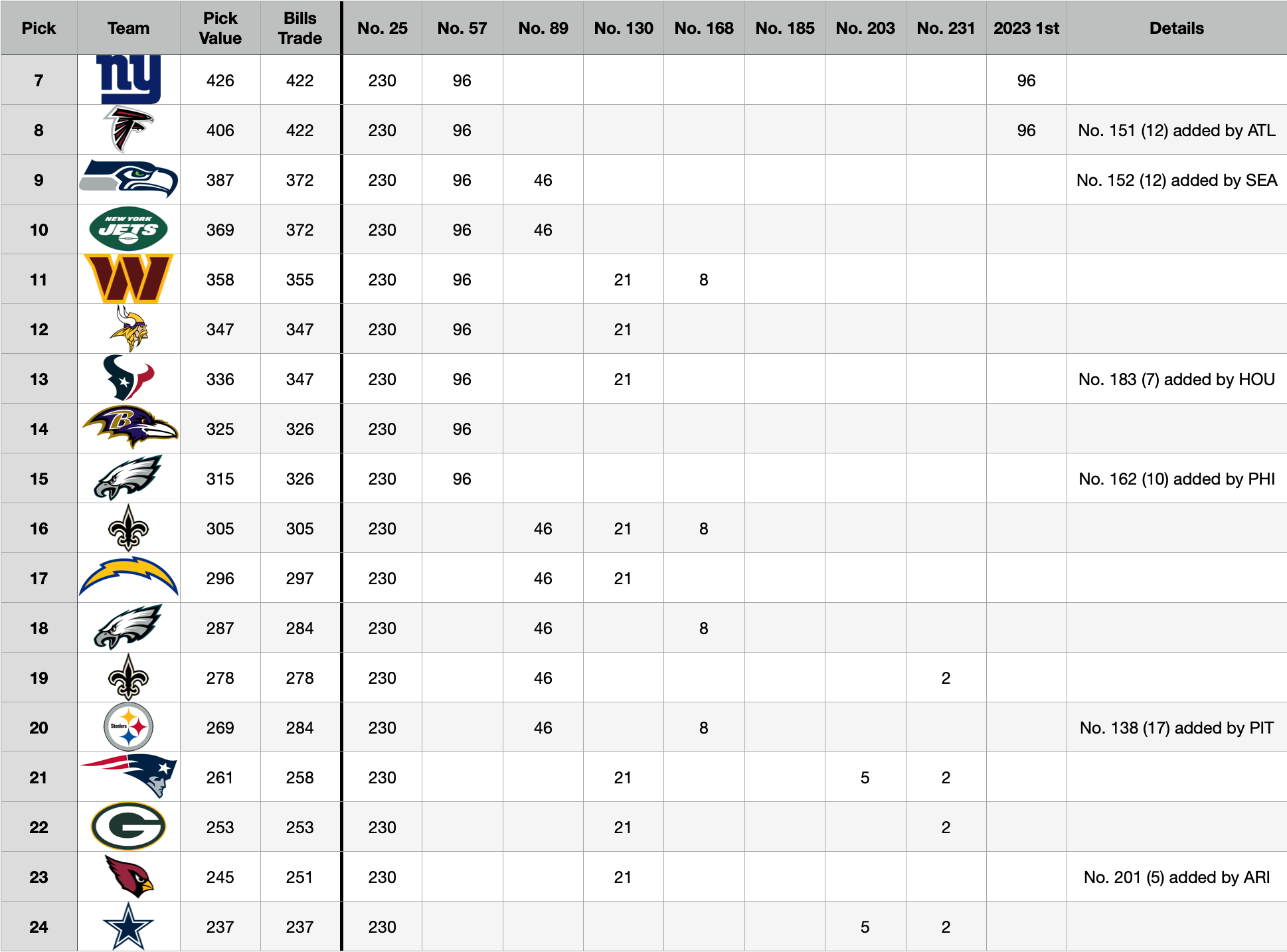
From that viewpoint, the sweet spot looks to be in that 13-15 range, where the Bills would be able to recoup a pick on the back end, give up only their second-round pick, or both. The cost is far less prohibitive past that 15th spot, but there is another thing to consider. Everyone is trying to move down this year, which could lower the cost to move up for a non-quarterback.
Within the past week, as the draft has drawn closer, multiple teams in the top half of the draft have inquired with others to try to trade back in the first round, per sources. So far, the interest in moving back in Thursday’s draft has greatly exceeded the interest in moving up.
— Adam Schefter (@AdamSchefter) April 25, 2022
Perhaps it would only take the team’s third-round pick rather than a second to move into the 13-15 range. Or maybe it only takes the second-round pick to move up to 11 or 12. Many believe Hamilton could be one of the best players available in this draft, and his stock is mostly harmed by perceived positional value. The Bills should explore every avenue because Hamilton could be exceptional in their scheme.
8. At No. 25, two safeties stand out
If they stay put at No. 25 and are looking at safety, it comes down to Michigan’s Dax Hill and Georgia’s Lewis Cine.
Hill is an intriguing player because of his range, fluidity and ball skills. He worked at nickel corner in college but can play both safety spots if needed. My only concern is where they’d try to fit him in over the next two years. He has excellent versatility, but he’s more Hyde than Poyer. Hill’s best fit is either at nickel corner or free safety, and both of those positions are spoken for over the next two seasons. They could also use Hill at boundary cornerback in his rookie year, then move him to strong safety. However, it seems like an adventurous projection for a franchise that often stays away from overloading first-year players.
The more I’ve thought about Cine to Buffalo, the more I like it. He has the versatility to play both spots but is best suited to strong safety, usually played by Poyer. Cine is an excellent striker, offers outstanding run support and stands out on film despite playing for a super-talented Georgia defense. He has great movement skills and impressive fluidity, does a great job of disguising his coverages and recovering post-snap and plays with the instincts the Bills value at safety. Like Poyer, Cine is a bit understated in his impact on a game, but his positioning and physicality meant a lot to Georgia’s defense. The Poyer role would be perfect for Cine, and he could become a top-flight safety in the Bills’ scheme. In 2022, he can play base linebacker, special teams and cover tight ends in subpackages. Cine is on my short list of players I believe are in serious consideration at No. 25.
9. If they go offense, running back remains a first-round option
The Bills taking a running back is polarizing among the fan base, but they’ve hinted they’d like to get better at the position. First is the Singletary factor as he has only one year remaining on his contract. You could say the same for interior offensive line, but given their past draft investments, they value running back more than guard. With rising cap costs, Singletary is likely lower on the possible extension list than teammates like Oliver, Knox and Edmunds.
The Bills will want to have a succession plan in place without relying on a first-year player at running back. There is also a huge drop-off on the depth chart from Singletary to Zack Moss or Duke Johnson. Should anything happen to Singletary, the Bills will become an entirely predictable pass-first offense. On multiple occasions last season, McDermott stressed having the “threat to run” to challenge a defense. The Bills offense didn’t explode until they worked in more two-tight-end formations, and Singletary began to play well near the end of the season. The last thing the Bills want is to lose that by having poor depth behind Singletary.
There also has been a lot of offseason talk about protecting Allen, and one way to do that is by not calling so many quarterback runs. Some scrambles are inevitable, but the Bills know the only way they will win a Super Bowl is if Allen is healthy. A high-level investment in a running back who can challenge a defense in dynamic ways is an excellent way to give their quarterback plays off. It wouldn’t necessarily encourage the Bills to run the ball more, but it would allow them to run more effectively and avoid unnecessary hits on Allen.
And the most important point, the Bills are perfectly fine taking a running back in the first round if that player is atop their board. Beane acknowledged the team had running backs, plural, with first-round grades over the past four drafts. That means more than just Saquon Barkley in 2018. There was reported interest in Travis Etienne last year, which seemed legitimate. If there is an explosive back with home-run potential who can add to their passing game, the Bills could easily take one in the first round. And there might be one that possesses all of those qualities.
10. Why Breece Hall is a great fit
Generally speaking, the Bills have tried to swing for the fences with their first-round pick every time under Beane. Allen, Edmunds, Oliver and Rousseau are all high potential prospects that had the ceiling to ascend to one of the best at their position. Just as it rings true in a trade-up for Hamilton, the same goes for Iowa State running back Breece Hall. The Bills have plenty of things they’re looking for in a new running back, and Hall has the potential to check every box to become a genuine three-down threat.
The Bills do not have anything like Hall on their roster. It’s why he’s in the discussion for the No. 25 pick or a trade-back scenario. He has excellent size, speed and explosiveness, all while playing with tremendous patience. That home-run element of turning something into nothing in the open field and then the build-up speed to pull away from defenders is something neither Singletary nor Moss possesses. That helps put him above the other running back prospects.
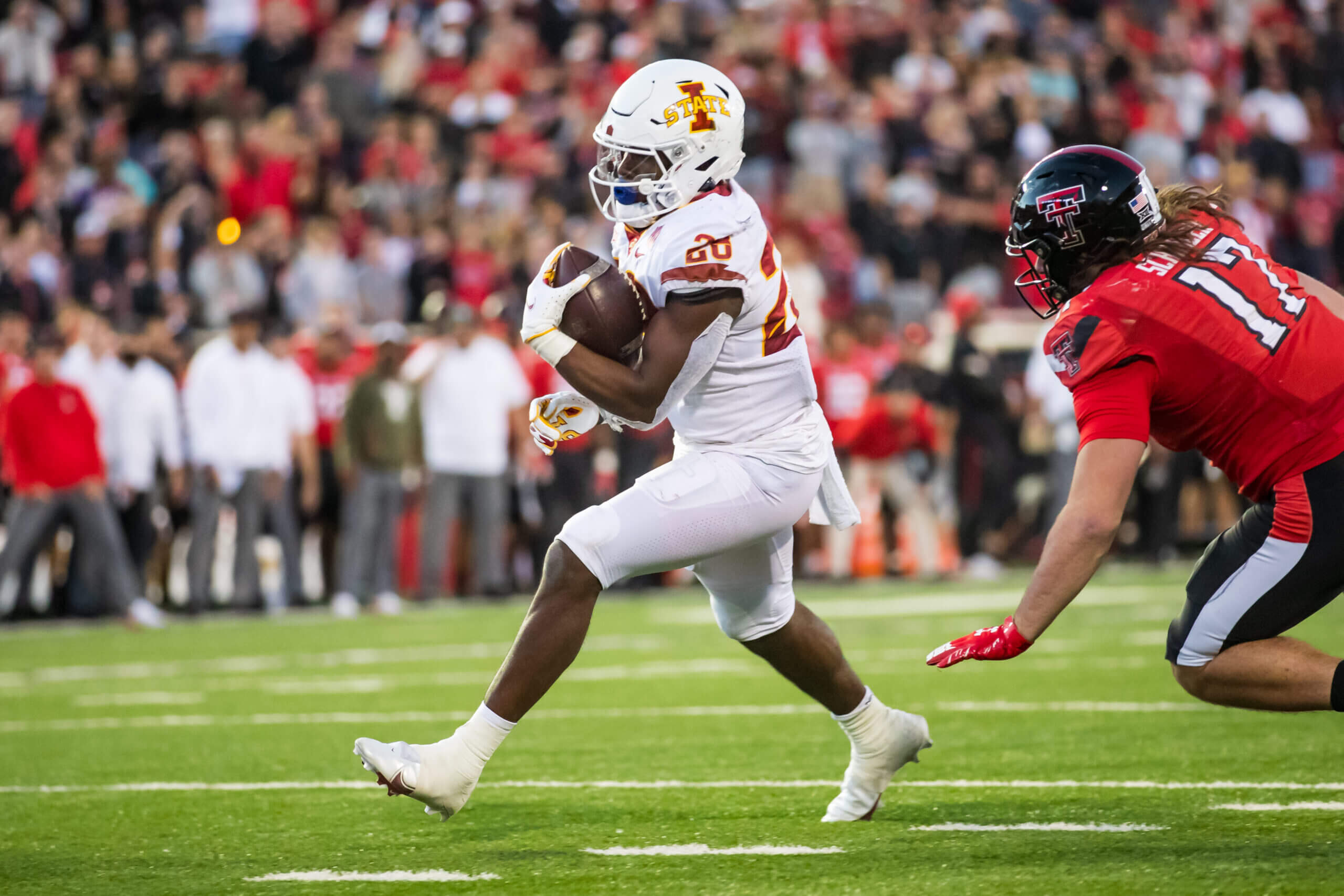
Iowa State’s Breece Hall would give the Bills traits their running game is lacking. (John E. Moore III / Getty Images)
His patient running style is ideally suited to the zone blocking principles the Bills are likely to use more, where Hall can read his keys and get upfield after he reads the line and chooses the optimal lane. He’s also a third-down threat with a good baseline of skills and the potential to improve as a pass catcher and blocker. In his annual draft guide, The Beast, The Athletic’s draft expert Dane Brugler pointed out that possibility. “Smooth body control as a pass catcher to adjust and pull in erratic throws,” Brugler said. “Gutsy in pass protection with the poise and power to get better.” Hall had 82 catches over three seasons and averaged 9 yards per reception.
Hall turns 21 at the end of May, which matches the Bills’ usual lean with their first-round pick. According to Player Profiler, his best comparable NFL player, based on advanced metrics and workout scores, is Colts star running back Jonathan Taylor. Hall would be a fascinating fit in Buffalo’s offense.
11. What about receiver or guard in Round 1?
A receiver is a good option in theory, but a few things stand in the way. The first goes back to what Beane said in 2021. They have an excellent top four, and three of those are signed through the 2023 season (Stefon Diggs, Gabriel Davis and McKenzie). They are not hurting for depth at receiver and still have a pair of developmental assets in Marquez Stevenson and Isaiah Hodgins. So a roster spot could become an issue, especially if the Bills select a running back.
Second, if the Bills wind up using more two-tight-end formations, as their offseason activity indicates, that takes the third receiver off the field. Because of that approach, the need to add another prime resource to the receiver corps could be reduced. And last, both McDermott and Beane don’t seem concerned about finding receiver talent in future drafts.
“I think you’re going to see receivers every year from now on being one of the deeper classes because of all the seven-on-seven, all the passing that’s started on the youth level,” Beane said last week. “You go watch Pop Warner football, they’re chucking the ball. That’s going to be a position that will generally be one of the deep ones in every draft.”
With a star receiver in Diggs and a budding star in Davis, a third receiver might be a bit of overkill in the first round.
Interior offensive line became less of a pressing need once center Mitch Morse signed a two-year extension through 2024. The Bills need a guard to develop for depth in 2022 and potentially to start in 2023, but they have never assigned big-money resources or primary draft capital on one. They might better use the first-round pick on another position so the Bills can take advantage of the interior line depth of this year’s class. But if their board falls completely flat, Boston College’s Zion Johnson could be a fallback option with long-term potential to play center. Still, it’s unlikely the Bills will invest a premium resource in a guard.
12. Trading down might be difficult, but …
Beane revealed that the Bills do not have 32 first-round grades in 2022, which is more common than you’d think. It could be problematic if they go on the clock and no players left with a first-round grade are available. In that case, Beane said he’d look to trade down. The difficulty is that the Bills are likely not alone in thinking this class lacks top-end appeal. For as much that the Bills could benefit from a move up at a slightly reduced cost, they might not receive a trade package worth moving down from No. 25. That is, except for one scenario.
If the quarterbacks fall outside the top 15, an opportunity might arrive. As of now, if those quarterbacks are still available, the Saints (Nos. 16 and 19) and the Steelers (No. 20) would be the most plausible spots for a quarterback run to begin. There isn’t another quarterback threat after the Steelers until the Titans pick at No. 26, as many regard Tennessee as a sneaky team to use its first pick on that position. That’s where the Bills can benefit because they have the pick directly ahead of the Titans.
The Lions could be the team to move up because they own both Nos. 32 and 34. The Bills could trade down to one of those spots and swap their fourth-round pick (No. 130) for the Lions’ early third-round pick (No. 76). The other team I’m keeping my eye on in a potential Bills trade-down scenario is Seattle. The Seahawks own the 40th and 41st picks and could easily move up without sacrificing their only second-round pick. A trade could yield the Bills pick Nos. 40, 72 and 152.
13. The age factor
Before we dive into Day 2, let’s take a quick aside. The Bills are now four drafts into Beane’s tenure as the team’s GM, which is enough of a sample size to spot some trends. In the early rounds, one of them is the prospect’s age at the time of selection. And Beane typically veers young with his premium picks. Since the 2018 NFL Draft, the Bills have selected four players in the first round and 12 players in the first three rounds.
Early round Bills draft ages, 2018-2021
We’ll start with the first round. On the day they were selected, Allen, Edmunds, Oliver and Rousseau had an average age of 21.09 years old. Allen was the oldest of the four prospects at 21.93. Edmunds’ age on draft day (19.98) is an anomaly that could skew the data. However, even if Edmunds were a year older, the average age would still only be 21.34. It’s only four picks and could be nothing more than a tiebreaker between similarly graded prospects, but it’s worth noting that Beane has leaned young. Regardless, here are the ages of the top prospects within first-round consideration at the six possible positions.
Potential Bills first-round target ages PlayerPositionAge on draft dayBills 1st Round +/-Bills Top 3 Round +/- Breece HallRB20.910.181.05
Breece HallRB20.910.181.05 Kaiir ElamCB20.980.110.98
Kaiir ElamCB20.980.110.98 Kyle HamiltonS21.12-0.030.84
Kyle HamiltonS21.12-0.030.84 Kenyon GreenIOL21.12-0.030.84
Kenyon GreenIOL21.12-0.030.84 Nakobe DeanLB21.38-0.290.59
Nakobe DeanLB21.38-0.290.59 Kenneth Walker IIIRB21.52-0.430.44
Kenneth Walker IIIRB21.52-0.430.44 Daxton HillS21.58-0.490.38
Daxton HillS21.58-0.490.38 Andrew Booth Jr.CB21.58-0.490.38
Andrew Booth Jr.CB21.58-0.490.38 Trent McDuffieCB21.63-0.540.34
Trent McDuffieCB21.63-0.540.34 Skyy MooreWR21.63-0.540.33
Skyy MooreWR21.63-0.540.33 Chris OlaveWR21.84-0.750.12
Chris OlaveWR21.84-0.750.12 Quay WalkerLB21.97-0.88-0.01
Quay WalkerLB21.97-0.88-0.01 Tyler LinderbaumC22.06-0.97-0.10
Tyler LinderbaumC22.06-0.97-0.10 Treylon BurksWR22.10-1.01-0.14
Treylon BurksWR22.10-1.01-0.14 Jahan DotsonWR22.10-1.01-0.14
Jahan DotsonWR22.10-1.01-0.14 Kyler GordonCB22.36-1.27-0.40
Kyler GordonCB22.36-1.27-0.40 Zion JohnsonIOL22.44-1.35-0.48
Zion JohnsonIOL22.44-1.35-0.48 Lewis CineS22.56-1.47-0.60
Lewis CineS22.56-1.47-0.60 Chad MumaLB22.69-1.60-0.73
Chad MumaLB22.69-1.60-0.73 Devin LloydLB23.58-2.49-1.62
Devin LloydLB23.58-2.49-1.62
The average age increases when you include the second and third rounds but remains relatively low because of the first round. Their early-round average age is 21.96, but when you take out the four first-round choices, that goes up to 22.40. Prospects aged 22 and up at the time of selection made up six of their eight picks in the second and third rounds. However, they didn’t go too far over until last year. Before selecting Boogie Basham (23.37) last year, the Bills had not taken a player older than 22.45 out of the 10 early-round prospects. One round later, they chose Spencer Brown (23.17). It is fair to wonder if selecting older players last year may have been a product of a condensed draft pool because of the pandemic. Either way, age has mattered less to the Bills on Day 2.
14. OK, back to cornerback. Who fits the profile?
There are two characteristics the Bills typically like to invest in with boundary cornerbacks. First, the player needs to be a good tackler because of how they position the edge rushers, and they prefer longer arms to help disrupt passes in the standard zone defense. Over the last five years, the nine boundary cornerbacks the Bills have used in the starting lineup have had an average arm length of 31.5 inches. But dating to Beane and McDermott’s Carolina days, that average goes up dramatically with player selected in the first five rounds. The average arm length of Tre’Davious White, Josh Norman, James Bradberry and Daryl Worley is 32.906 inches, and no player’s arm length was 32.125 inches. Using both the premium draft and Bills starter thresholds, here is how the top 25 available cornerbacks relate to the Bills’ past preferences.
CB arm length vs. Bills thresholds Player Brugler Rank Arm Length Premium Draft +/- Bills Starter +/-  Ahmad Gardner533.5000.5942.000
Ahmad Gardner533.5000.5942.000 Trent McDuffie1229.750-3.156-1.750
Trent McDuffie1229.750-3.156-1.750 Derek Stingley Jr.1430.625-2.281-0.875
Derek Stingley Jr.1430.625-2.281-0.875 Andrew Booth Jr.2631.500-1.4060.000
Andrew Booth Jr.2631.500-1.4060.000 Kaiir Elam4530.875-2.031-0.625
Kaiir Elam4530.875-2.031-0.625 Kyler Gordon5131.000-1.906-0.500
Kyler Gordon5131.000-1.906-0.500 Roger McCreary5528.875-4.031-2.625
Roger McCreary5528.875-4.031-2.625 Cam Taylor-Britt5731.500-1.4060.000
Cam Taylor-Britt5731.500-1.4060.000 Marcus Jones7028.875-4.031-2.625
Marcus Jones7028.875-4.031-2.625 Tariq Woolen8133.6250.7192.125
Tariq Woolen8133.6250.7192.125 Coby Bryant8730.625-2.281-0.875
Coby Bryant8730.625-2.281-0.875 Joshua Williams9332.875-0.0311.375
Joshua Williams9332.875-0.0311.375 Damarri Mathis9631.875-1.0310.375
Damarri Mathis9631.875-1.0310.375 Zyon McCollum10230.750-2.156-0.750
Zyon McCollum10230.750-2.156-0.750 Jalyn Armour-Davis11730.875-2.031-0.625
Jalyn Armour-Davis11730.875-2.031-0.625 Akayleb Evans12132.000-0.9060.500
Akayleb Evans12132.000-0.9060.500 Tariq Castro-Fields13030.750-2.156-0.750
Tariq Castro-Fields13030.750-2.156-0.750 Josh Jobe14432.625-0.2811.125
Josh Jobe14432.625-0.2811.125 Jaylen Watson15032.250-0.6560.750
Jaylen Watson15032.250-0.6560.750 Kalon Barnes15931.750-1.1560.250
Kalon Barnes15931.750-1.1560.250 Martin Emerson16733.5000.5942.000
Martin Emerson16733.5000.5942.000 Cordale Flott16930.125-2.781-1.375
Cordale Flott16930.125-2.781-1.375 Cobie Durant18630.750-2.156-0.750
Cobie Durant18630.750-2.156-0.750 Damarion Williams18829.625-3.281-1.875
Damarion Williams18829.625-3.281-1.875 Chase Lucas19631.875-1.0310.375
Chase Lucas19631.875-1.0310.375 Dallis Flowers24232.000-0.9060.500
Dallis Flowers24232.000-0.9060.500
Ahmad Gardner is the only early-round prospect whose arm length is slam dunk for a draft pick, but he’ll be long gone by the time the Bills pick. Of the other first-round candidates, Booth is the only one who hits the Bills starter threshold, but he falls more than an inch shy of the premium draft resource threshold. The other three standouts with arm length are Tariq Woolen of UTSA, Martin Emerson of Mississippi State and Joshua Williams of Fayetteville State.
According to Brugler, Woolen is “currently untrustworthy in run support” with “too many fly-by tackle attempts because of below-average technique and finishing skills.” That gives me pause about Woolen as a fit in Buffalo. Emerson seems like a potential fit for the Bills as a cornerback and on special teams, but Brugler pointed out he needs to clean up his run support. Emerson has visited the Bills in the pre-draft process.
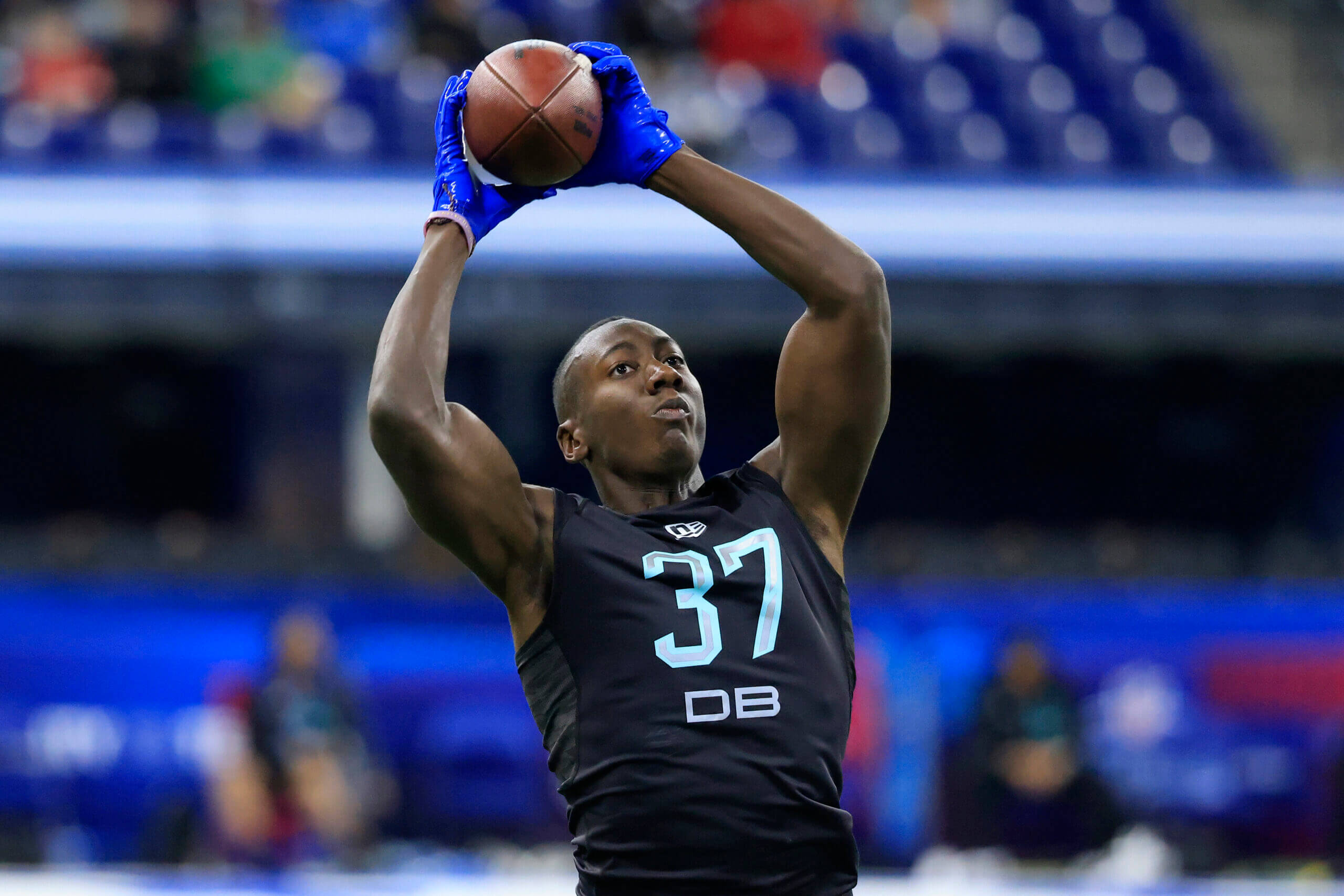
Joshua Williams is the type of cornerback prospect Bills GM Brandon Beane loves. (Justin Casterline / Getty Images)
Of the three, Williams is my top fit for the Bills for more than just his arm length and willingness as a run defender. He’s a former wide receiver who only transitioned to cornerback as a senior in high school, which means there is a lot of growth potential. The Bills love having defensive backs who have something to prove, and Williams’ journey has put him in that position. He didn’t receive a single offer out of high school, much like Levi Wallace, then had to go to a prep school. He received offers after one year there but only from Division II programs. Williams has had to fight to become a legitimate draft prospect. With his size, untapped potential, drive and what Brugler calls a “coachable attitude,” I could see McDermott and Beane identifying him as a perfect prospect to develop into a long-term starting cornerback.
15. If not Hall at RB, then who?
The one player I keep coming back to is Isaiah Spiller. There have been multiple signs this offseason that the Bills may be looking to run more zone principles, and Spiller was outstanding running those concepts at Texas A&M. With 74 receptions in three seasons, Spiller is also an accomplished pass catcher out of the backfield who didn’t drop a single pass last year. His pass protection is far more consistent than others in the class and can help him stay on the field.
His slow 40 time is a primary issue, but with how he maximizes chances in the open field and his play speed, the Bills will likely be willing to look past that. Beane trusts his eyes on film when scouting running backs, so he’s not likely to be swayed by one subpar workout. Spiller would be an extremely enticing option at No. 57.
In the third round, Georgia’s James Cook is an intriguing possibility for his pass-catching prowess alone. If they were to move back from No. 25 and secure an early pick in the fourth round, they might even be able to get him there. Hall, Spiller and Cook appear to be the three who would give the Bills something they don’t have on their roster.
Michigan State’s Kenneth Walker III, he becomes more of a projectional fit for what they don’t have than Hall, Spiller or Cook. The Spartans used Walker as a pass catcher sporadically, which isn’t as big an issue as his pass blocking. Brugler detailed the weaknesses in The Beast.
“Low batting average as a pass blocker, and his technique needs to be rebuilt from the ground up … guilty of half-hearted cuts or shoulder chips … only 19 career catches and untested as a route runner … inconsistent finishing skills when targeted away from his body.”
Despite Walker’s exciting one-cut style, his weakness may make him a nonstarter for the Bills. He’s a pure rusher prospect, but it’s a slightly tougher sell with the unknown third-down ability. They also have not had any reported contact with Walker in the pre-draft process.
16. Day 2 WRs of interest
If the Bills don’t take a running back in the early rounds, that certainly puts receiver back into the conversation — but with a specific type in mind. The Bills should first look for a receiver who can do a little bit of everything, including home-run ability and yards after catch potential. Taking handoffs out of the backfield and on jet sweeps wouldn’t hurt, either. Players such as Wan’Dale Robinson of Kentucky and Calvin Austin III of Memphis stand out with that vision in mind.
If that’s unavailable, a technician of a slot receiver wouldn’t be a bad consolation prize. Alabama’s John Metchie III and Boise State’s Khalil Shakir stand out as Day 2 prospects who would fit those parameters. Penn State’s Jahan Dotson and Western Michigan’s Skyy Moore will likely be long gone when No. 57 rolls around. They would enter the equation if the Bills traded down from No. 25 and into the early second round. However, if the Bills take a running back early, I would not be surprised if they punt on wide receiver or only use a late-round flier on someone.
17. Interior offensive lineman shaping up as a Round 2-5 must have
Once the Bills signed Saffold and matched Ryan Bates’ four-year offer sheet from Chicago, the starting lineup seemed set on the offensive line. But the one thing that remains unsettled is the depth at guard and center behind Saffold, Bates and Morse. The top reserve is Ford, who has struggled and isn’t as strong as a fit with the offensive linemen they’ve been adding. Past him, all the Bills have is David Quessenberry, Greg Mancz and Ike Boettger, and Boettger likely still has a long road to recovery from a late-season torn Achilles.
At best, the depth is unsettling, which means the Bills need an infusion of youth and talent. Regardless if it’s a guard only, a guard who can play tackle in a pinch, or a guard who can also play center, interior depth is one of their most prominent mid-round needs.
18. The Bills’ recent OL building trend and names to monitor
I mentioned that Ford isn’t as strong of a fit anymore, and that’s because the Bills have recently made it a point to invest in offensive linemen with great athletic profiles. An excellent tool to measure a prospect’s composite workout score is the Relative Athletic Score. It factors in size, speed, strength, agility and explosiveness drills in a player’s draft year relative to the historical date of players at their position. The closer the score is to 10, the better the athlete. The Bills’ presumed top six linemen that they’ve spent premium offseason resources on lean a certain way.
2022 Bills OL Relative Athletic Scores
The average of those six players is 9.40. If you remove Dawkins, whom they invested a long-term deal into before this new wave of athletic signings began, the Relative Athletic Score average bumps up to 9.70. They also jettisoned Daryl Williams (3.31) and Jon Feliciano (3.17) this offseason. Plus, recent signee David Quessenberry had a 9.44. They seem to have a type. So which interior prospects reflect well with a Relative Athletic Score?
IOL Prospect Relative Athletic Scores PlayerBrugler RankRelative Athletic ScorePremium Resource +/-Without Dawkins +/- Bernhard Raimann369.970.570.27
Bernhard Raimann369.970.570.27 Cole Strange739.950.550.25
Cole Strange739.950.550.25 Cam Jurgens499.940.540.24
Cam Jurgens499.940.540.24 Zach Tom1319.930.530.23
Zach Tom1319.930.530.23 Zion Johnson229.750.350.05
Zion Johnson229.750.350.05 Dawson Deaton2419.700.300.00
Dawson Deaton2419.700.300.00 Logan Bruss1429.620.22-0.08
Logan Bruss1429.620.22-0.08 Chris Paul1979.450.05-0.25
Chris Paul1979.450.05-0.25 Sean Rhyan949.33-0.07-0.37
Sean Rhyan949.33-0.07-0.37 Zachary Thomas2349.00-0.40-0.70
Zachary Thomas2349.00-0.40-0.70 Tyler Linderbaum198.84-0.56-0.86
Tyler Linderbaum198.84-0.56-0.86 Dylan Parham728.80-0.60-0.90
Dylan Parham728.80-0.60-0.90 Alec Lindstrom2278.35-1.05-1.35
Alec Lindstrom2278.35-1.05-1.35 Joshua Ezeudu1018.32-1.08-1.38
Joshua Ezeudu1018.32-1.08-1.38 Spencer Burford1338.24-1.16-1.46
Spencer Burford1338.24-1.16-1.46 Nicholas Petit-Frere997.78-1.62-1.92
Nicholas Petit-Frere997.78-1.62-1.92 Cade Mays1987.56-1.84-2.14
Cade Mays1987.56-1.84-2.14 Justin Shaffer1417.53-1.87-2.17
Justin Shaffer1417.53-1.87-2.17 Ed Ingram1147.41-1.99-2.29
Ed Ingram1147.41-1.99-2.29 Luke Fortner757.29-2.11-2.41
Luke Fortner757.29-2.11-2.41 Dohnovan West1727.01-2.39-2.69
Dohnovan West1727.01-2.39-2.69
If the Bills hold to their trend, keep an eye on these names as the draft gets deeper. The Bills have had pre-draft visits with Sean Rhyan (9.33), Dylan Parham (8.80), Joshua Ezuedu (8.32), Spencer Burford (8.24) and Nicholas Petit-Frere (7.78).
19. Linebacker is in the same boat as interior offensive line
With Edmunds’ contract situation and a lack of dependable depth behind him and Matt Milano, it seems essential for the Bills to take a linebacker in the first five rounds. Although a polarizing player, Edmunds has the profile that the Bills usually invest in with cap space. It’s unclear if that’s their plan, but if so, there won’t be as much of push for an early-round linebacker. Even with Edmunds on a long-term deal, they need someone who can capably fill in for base formations and be the replacement if one of the starters suffers an injury. If the Bills trade up for Hamilton, that could be a way to satisfy the need for only 2022. If not, anywhere from the second to the sixth round should be in play.
20. Day 2 safeties to monitor
If the Bills don’t move up for Kyle Hamilton and decide on a different position in the first round, or if they move out of the first round, they’ll have some options. We mentioned Lewis Cine earlier as an option at 25 if they have to stay put, but he should also be someone to watch in a trade-down scenario. Cine appears to be on the first- and second-round line. Depending on how far down the Bills might trade down, Cine could be an option. Past Cine, Maryland’s Nick Cross is well-suited to the Bills’ scheme as a hybrid safety. As a free safety on his best reps, he exhibits excellent patience when he needs to play the deep middle, and then at strong safety, he brings the physicality to get downhill in a hurry, which the Bills love. Cross could be a steal on Day 2 if he pairs some of his risk-taking with developing instincts and recognition skills over time. Cincinnati’s Bryan Cook is another strong fit for the Bills in the third round.
21. Don’t ignore all the pre-draft work on tight ends
If you go through the pre-draft visitors list, which Ryan Talbot of Syracuse.com did an excellent job compiling, you’ll notice a lot of names on the tight end list. They’ve had Isaiah Likely (Coastal Carolina), Jalen Wydermyer (Texas A&M) and James Mitchell (Virginia Tech) in for a top-30 visit. They also held a private workout with Trey McBride (Colorado State). The logic for adding a tight end makes sense, too. The Bills don’t have any tight ends signed beyond 2022, and with how successful they were running two-tight-end formations at the end of last season, they’ll likely want a plan in place. Drafting one this year would give that player a redshirt year before taking over as Knox’s backup. Round 3 or later seems like the appropriate range given their need.
22. Get ready: It’s almost #Puntapalooza time
The Bills don’t have many roster spots open, and Beane wants to take advantage of the four-year rookie contracts by selecting players who can make the team this year. That should put a punter on the draft radar, and I wouldn’t rule out a punter on Day 3 — even in the fourth round. The top two this year, San Diego State’s Matt Araiza and Penn State’s Jordan Stout, are compelling because they compare well with the last two Bills punters. Araiza is a big-legged punter like Corey Bojorquez, who may have less precision than other punters but can completely flip the field. Stout is more like what the Bills wanted Matt Haack to be, not having as big of a leg but offering more consistency and accuracy to pin teams deep. Both punting approaches have compelled the Bills, so it’s wide open between them. It may come down to draft cost. Regardless of who it is, I’ve got my stopwatch ready.
(Top photo of Kyle Hamilton: Darren Lee / Cal Sport Media via ZUMA Wire / Associated Press)
!function(f,b,e,v,n,t,s)
{if(f.fbq)return;n=f.fbq=function(){n.callMethod?
n.callMethod.apply(n,arguments):n.queue.push(arguments)};
if(!f._fbq)f._fbq=n;n.push=n;n.loaded=!0;n.version=’2.0′;
n.queue=[];t=b.createElement(e);t.async=!0;
t.src=v;s=b.getElementsByTagName(e)[0];
s.parentNode.insertBefore(t,s)}(window, document,’script’,
‘https://connect.facebook.net/en_US/fbevents.js’);
fbq(‘dataProcessingOptions’, []);
fbq(‘init’, ‘207679059578897’);
fbq(‘track’, ‘PageView’); .
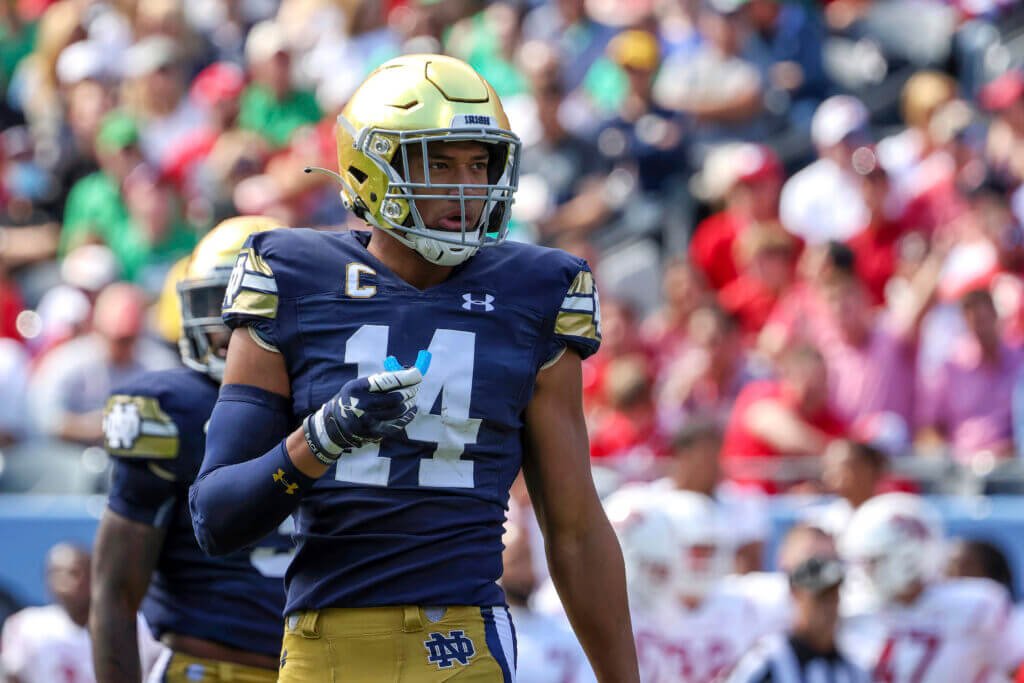

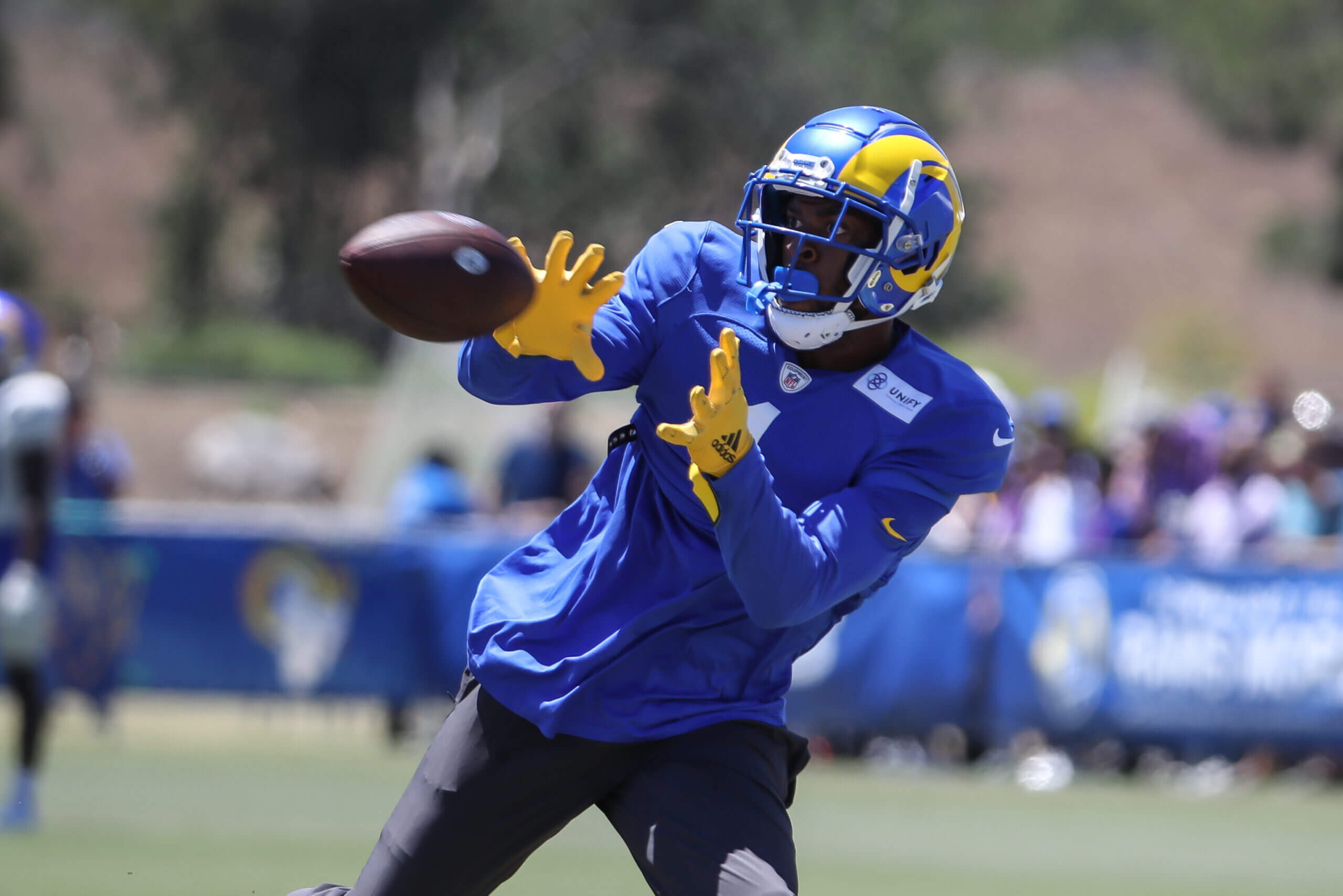


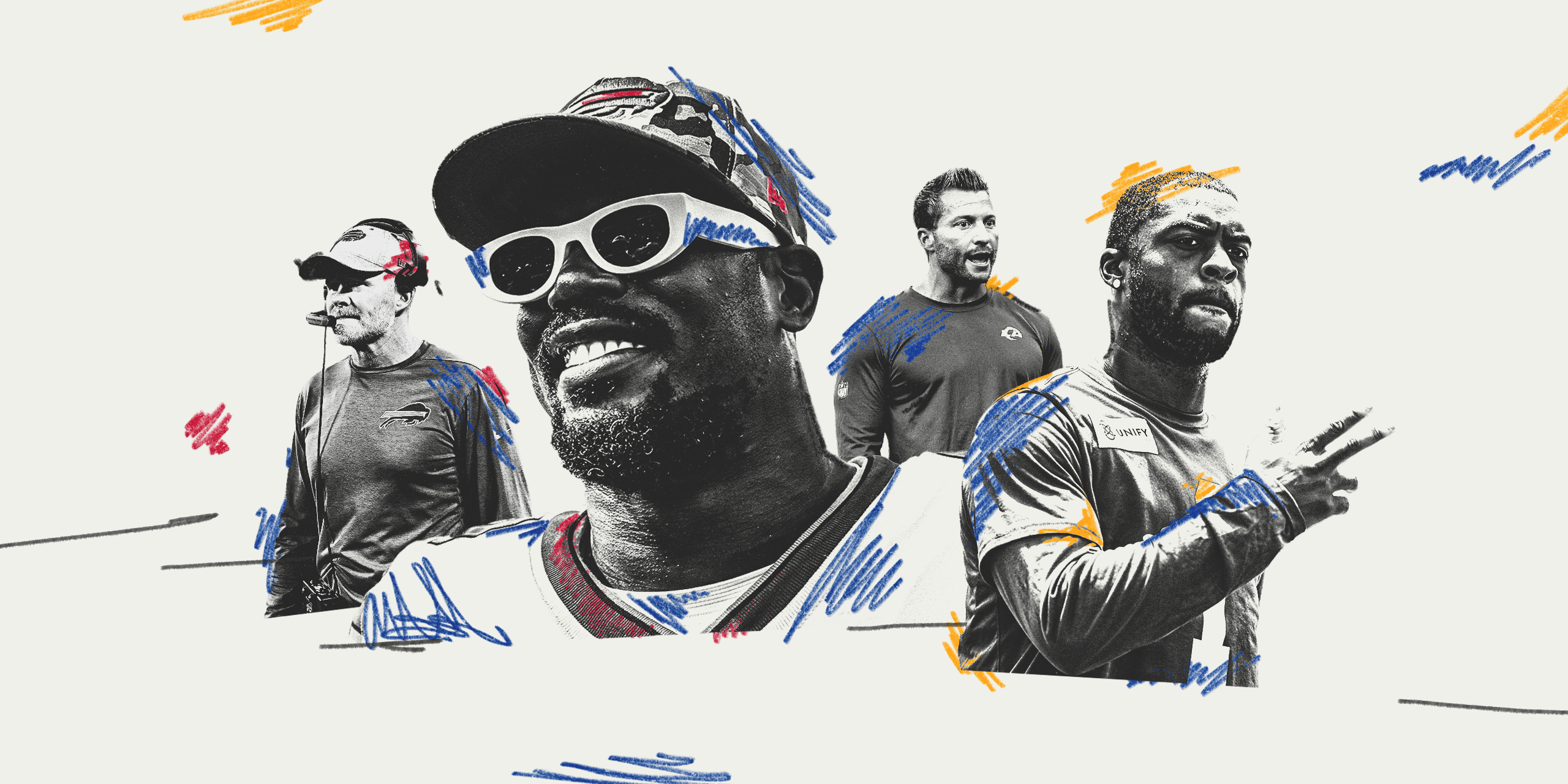



















































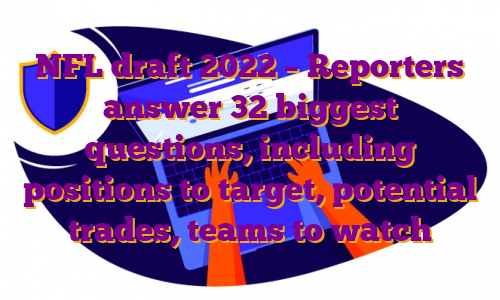
 AFC EAST
AFC EAST AFC NORTH
AFC NORTH • Ranks: Kiper » | McShay » | Positions »
• Ranks: Kiper » | McShay » | Positions »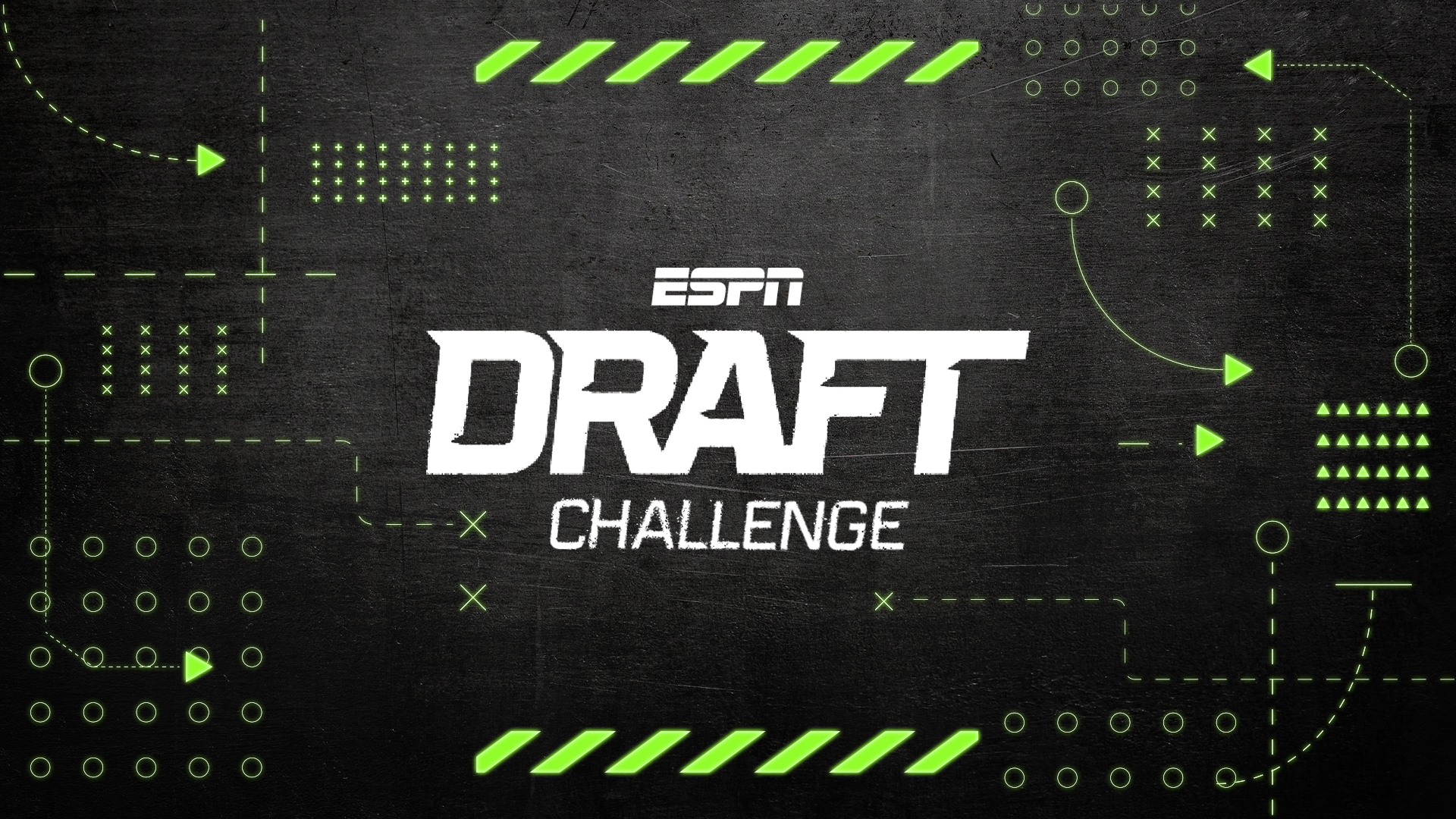 Answer questions on the 2022 NFL draft for a chance to win $100,000! Make Your Picks
Answer questions on the 2022 NFL draft for a chance to win $100,000! Make Your Picks